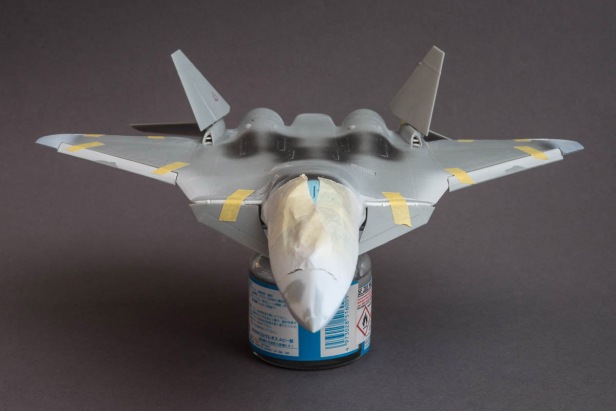After a short vacation I am back with PAK-FA build!
As I want to depict aircraft at rest with engines shut down, several modifications are needed. As is the case with most aircraft, hydraulically operated control surfaces drop when the former bleeds off after some time.

I have already prepared the ailerons so I’ll show you, how I prepared the flaps. I first glued the flaps actuator covers to the bottom of the wing.

In the next step, I temporary attached flaps to the upper wing with some masking tape and as the flaps were in the correct position, I glued the actuator covers to the flaps.

Next step was cutting off the flaps actuator covers attached to the flaps.

The material of the actuator covers is quite thick so it needs to be thinned. I just used fresh No.11 blade to scrape the interior of it. You can see the difference between the thinned and freshly cut covers on the above photo. What you achieve by thinning is that the narrower cover will slide into a wider (and thinned on the inside) cover, that’s fixed on the wing.

I attached an Evergreen half round strips to the edges of flaps, ailerons and slats.

Half round strips were also used for the rounded mounting points for LEVCONs.

HobbyBoss’ kit depicts early 1st and 2nd prototypes. They were not equipped with radar and featured several panels on the nose which were removed on later models and had to be filled and sanded. Also the massive nose mounted pitot tube is missing on later prototypes and had to be cut off in the kit and nose remodeled using some putty and sanding sticks.

The base of the tails feature air inlets with a splitter plate in the middle. Basic plastic parts had just a shallow representation of these intakes so I cut them out, sanded and added the splitter plates made of sheet styrene.


And here she is – All the manuvering surfaces temporarily attached to finally show her shape. There are some little things still to be done, but she is surely getting to the primer stage.


Always a pleasure watching your builds Sebastijan. This Pak-fa build will be a great reference for all who want to build a later model of the Russian stealth aircraft.
Thank you! Be aware though, that each prototype is slightly different and referencing my build could lead to inaccuracies with later prototypes (T-50-6 and above).